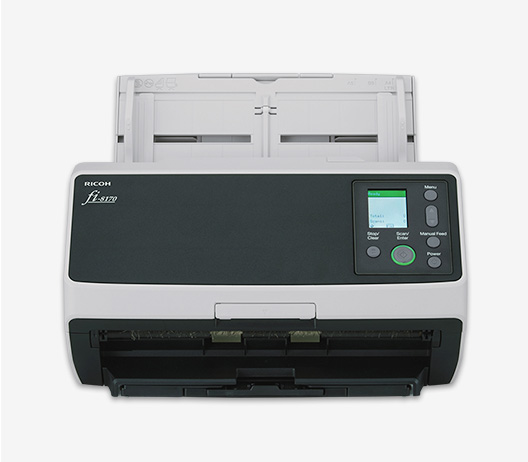
fi-8170
The Next Generation of Scanning Excellence
Founded in 1979, TeamHealth helps healthcare organizations respond to the wide range of challenges they face in terms of financial performance, healthcare reform, evolving government mandates and personnel shortages. This Knoxville, Tennessee-based company has grown rapidly over recent years into one of the country's largest providers of hospital-based clinical outsourcing.
Can a company virtually eliminate its paper problem in the midst of a rapid growth cycle? In the case of TeamHealth, the answer was yes. The quickly expanding health professional outsourcing firm not only eliminated the use of paper for physical transfer and storage with an electronic processing and billing workflow, it also paid off its investment in document scanners in less than two years.
“We’re one of the nation’s largest ED providers outsourcing staff for emergency rooms across the country, with physicians and allied health clinicians to service those facilities,” explained EDM Operations Director Mike Gager.
TeamHealth coded and billed for all of its provider encounters. When a physician or allied health clinician saw a patient at a partner facility, TeamHealth received the patient’s medical records from the facility describing the visit and the health issues the provider addressed. Accordingly, TeamHealth submitted claims to the insurance companies to get paid for providing those services.
Until 2007 only paper records were used. The TeamHealth physician or healthcare professional would write down each patient’s issues and put the document in a file, which was then copied and sent to the TeamHealth billing operation. That system worked well for a while, but the backlog of paper and its storage costs were growing. By 2008, a rising number of TeamHealth’s largest customers were beginning to use electronic records.
This transition posed a major challenge because many of TeamHealth’s smaller customers were still working with paper. To maintain an internal record for its operational coding workflow and keep its internal workflow efficient, TeamHealth had to replace its manual paper workflow with an electronic one. “We still had millions of paper records coming to us,” remembered Gager. “We had to find a way to improve that process and get those paper records into our electronic workflows.”
Staying disciplined was key. TeamHealth set a goal to take all new facility partners directly into the new electronic workflow while continuing to whittle down the large backlog of existing facility partners.
Complicating the issue was TeamHealth’s rapid growth. At the onset of the project in 2007, TeamHealth was processing millions of paper charts per year. Since that time, chart volume nearly tripled. Training new employees was a constant challenge as was building the systems to conf rm records were captured correctly and verified in the system.
TeamHealth worked with KeyMark, a major reseller of document management solutions based in Liberty, S.C., to come up with an on-site scanning solution. The solution had to meet a number of stringent and sometimes conflicting requirements. TeamHealth’s on-site coordinators, who would be responsible for document scanning, typically worked with very little office space. Often times, they only had a locked drawer or cabinet to store their equipment, so the solution had to be desktop oriented and very compact. “The coordinators often share space with others, so it had to be small enough to fit in a drawer or occupy very little desktop space,” said Gager.
“We needed to move through a stack of paper pretty quickly,” said Gager. Reliability was also a high priority. “They needed the scanners to handle the heavy-duty cycles because charts come in every day,” he said.
At the same time, TeamHealth required a document scanning solution that would produce a high-quality image so that billing staff could clearly read the document. Duplex scanning was essential as well. To meet these challenging requirements, KeyMark suggested a fi Series document scanner that could integrated excellent performance with robust reliability.
To eliminate the initial massive backload of paper, KeyMark brought in a half dozen powerful fi Series production level document scanners and ran them on 12-hour shifts. Six months later the paper backload was eliminated! Along the way the TeamHealth group found other internal opportunities, particularly in HR, to eliminate paper.
“During the entire multi-year project, the fi Series scanners never failed. The value of the product has been tremendous,” said Gager. “I’ve never had anyone from management question me about going to another scanner.”
To complement the fi Series scanners, KeyMark representatives also recommended software from Kofax and OnBase, a leading enterprise content management software solution from Hyland.
Today, TeamHealth has over 100 fi Series scanners working on this project. With implementations around the country, one helpful strategy has been what Gager called a “cut-and-paste” approach. “We used the scanners along with cut-and-paste templates, so we could get up and running really quickly,” he explained. “It allowed us to deploy much quicker and get people into our electronic workflow faster.”
Were there challenges along the way? “Absolutely,” said Gager. “There were lots of questions working with so many different partners and customers,” he said, recalling that each hospital was different in its processes and no two hospitals were alike. “It was hard to get everyone on the same page,” he said. “Probably the biggest challenge was keeping the many implementations consistent and accurate so that each was as smooth and repeatable as possible.”
Despite the challenges, the payoff was worth the effort. Gager says an initial study pegged the ROI at less than two years. However, the real value of the project was getting everything into a central workflow and taking advantage of operational efficiencies. “The bulk of our expenses are not the coordinators at the sites,” he said. “It’s in the higher paid personnel who perform complex tasks like coding the documents.”
Improving the productivity of a larger group of personnel serving hundreds of customers offers tremendous dividends. “If I can save just 3 or 4 percent by having a more efficient electronic process, the project more than pays for itself.”